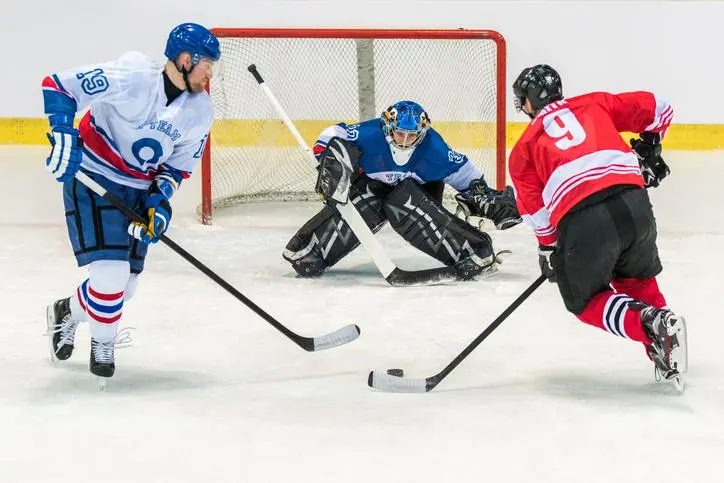Hockey is a sport rich with statistics that illuminate the nuances of the game, and one such statistic is the Faceoffs Won (FOW). So, what does Fow mean in hockey stats?
This figure is crucial in understanding which team controls the puck most often, setting the stage for either offensive plays or defensive stability.

What does Fow Mean in Hockey Stats?
In hockey statistics, FOW stands for Faceoffs Won. It measures how many times a team or player wins the initial possession after the referee drops the puck. This stat is critical as it directly correlates to how often a team controls the game’s flow.
Importance of FOW in Hockey
Winning faceoffs is a vital aspect of hockey because it determines which team gains immediate control of the puck.
Possessing the puck right from the start can significantly influence the game’s outcome, allowing a team to dictate the pace and style of play.
Teams that consistently win faceoffs often have better control over both offensive and defensive phases of the game.
How Is FOW Calculated?
Officials track faceoff wins and losses during a game. Each faceoff win is added to a team’s or player’s total FOW count.

This statistic is often shown alongside Faceoffs Taken (FOT) and Faceoff Win Percentage (FOW%), providing a complete picture of a team’s or player’s effectiveness at faceoffs.
Strategies for Winning Faceoffs
Players employ various techniques to win faceoffs, including quick wrist movements and strategic positioning of the stick and body.
Effective communication and positioning of fellow team members, especially wingers and defensemen, also play a crucial role in securing puck possession.
Mastering these techniques requires practice and a deep understanding of opponent tendencies.
Notable Players with High FOW Rates
Certain NHL players are renowned for their faceoff skills. These players practice extensively to perfect their timing and technique, significantly contributing to their teams’ strategy by increasing puck possession and control.
FOW and Its Impact on Team Strategies
Coaches analyze FOW statistics to develop game strategies that optimize their team’s strengths.
Effective faceoff players are often crucial in special team situations such as power plays and penalty kills, where gaining or maintaining puck possession is critical.
Teams might adjust their faceoff strategies based on the specific strengths and weaknesses of their opponents.
FOW in Fantasy Hockey and Betting
In fantasy hockey, understanding a player’s FOW can provide insights into their overall effectiveness and value to a team, making them a potentially valuable draft pick.

Bettors might look at a team’s FOW percentage as an indicator of their overall competitiveness in a matchup, influencing betting decisions.
How to Improve FOW Stats for Aspiring Players?
Aspiring players can improve their FOW statistics by practicing with teammates or coaches, focusing on quick reflexes, and studying successful faceoff takers.
Regularly practicing and analyzing video recordings of successful faceoffs can offer insights into effective strategies and techniques.
The Role of Centers in Faceoffs
In hockey, the center’s role during faceoffs is pivotal in securing initial puck possession. Their primary responsibilities involve timing, precision, and tactical awareness.
Centers must expertly align their bodies and sticks according to their strategic plan, leveraging their stance to anticipate and react to the puck’s drop swiftly.
Beyond physical readiness, centers need to outwit their opponents with quick decision-making and psychological acuity.
They employ a mixture of techniques, such as body positioning, stick placement, and hand-eye coordination, to gain the slightest advantage.
Moreover, adept centers will study and adapt to opposing players’ faceoff tendencies, adjusting their strategies in real-time to increase their chances of a win.
Skilled centers also demonstrate leadership by communicating with their teammates before each faceoff, coordinating actions that capitalize on won or lost draws.
Their abilities to read the game, elevate team cohesion, and execute planned plays from faceoffs are essential tools in the arsenal of a successful hockey team, directly impacting the game’s flow and outcome.
Historical Perspective on FOW
The strategic importance of Faceoffs Won (FOW) in hockey has steadily increased as the understanding of puck possession’s role in winning games has evolved.
Historically, FOW was a statistic of interest but lacked the detailed analytics applied today. The early days of hockey paid less attention to individual faceoff performance, focusing instead on broader aspects of the game like goals and assists.

As statistical analysis became more ingrained in the sport, particularly with the rise of advanced analytics in the late 20th and early 21st centuries, FOW gained prominence as a key performance indicator.
Teams began to realize that controlling faceoffs could lead to controlling the game tempo and, ultimately, the scoreboard.
Now tracked meticulously, each player’s FOW percentage is a stat scrutinized by coaches and analysts alike, influencing player evaluation and game strategy.
This metric’s evolution reflects hockey’s broader trend towards data-driven decision-making, highlighting the growth of the sport’s complexity both on and off the ice.
Pro Tips
Coaches often implement game plans that leverage their players’ faceoff strengths. They may adjust lineups and faceoff strategies based on real-time game data and opponent faceoff effectiveness.
Players and coaches spend considerable time understanding the psychological aspects, such as anticipating opponent moves and reacting swiftly during faceoffs.
You may also find useful: What is PIM in Hockey? | What Does SOG Mean in Hockey?
Frequently Asked Questions (FAQs)
What does a consistently high FOW% indicate about a player?
A high FOW% suggests the player is skilled at gaining puck possession for their team, providing strategic advantages.
Can a player improve their FOW% over time?
Yes, players can improve their FOW% with practice, better reflexes, and strategic learning.
How important is FOW to a team’s overall strategy?
FOW is crucial for dictating game pace and possession, impacting both offensive and defensive strategies.
Where can fans find FOW stats during games?
Fans can find FOW stats on sports networks and NHL game broadcasts, often updated in real time.
Is FOW considered when forming fantasy hockey teams?
Yes, FOW is a considered stat for drafting players in fantasy hockey as it reflects puck control skill.
Conclusion
FOW is a pivotal statistic in hockey, offering deep insights into a team’s control over the game.
By understanding and analyzing faceoff outcomes, fans, players, and coaches can gain a better appreciation of the strategic dimensions that faceoffs bring to hockey.

Matthew James is a passionate skater who wanted to create a platform to share his love for skating with others. With a vision to create a vibrant community of skaters, he aims to provide a space where skaters of all levels can connect, learn, and grow together.
